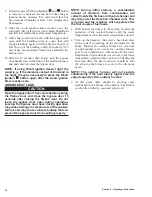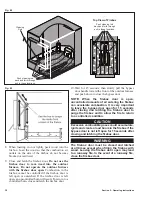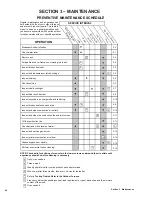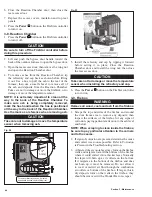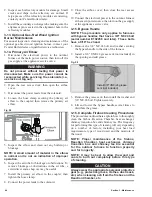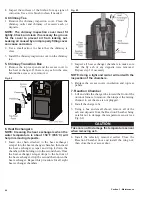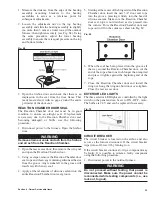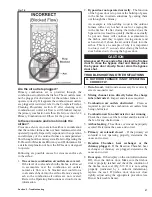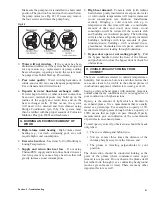
50
3. If the pH level is between 6.5 and 8.0 and there are
no other known water quality problems, then the
outdoor furnace may be filled with this water.
4. If the water to be used to fill the outdoor furnace has
a pH level of less than 6.5 or greater than 8, a sample
of the water should be sent to a water quality test
lab for recommended treatment, the water should
be conditioned, or water should be supplied from a
different source.
Corrosion Inhibitor Plus™ and Initial
Treatment
Central Boiler Corrosion Inhibitor Plus™ (p/n 1650)
gives optimum protection when it is used to initially
treat the water and is then maintained at proper levels.
The initial nitrite level target is 20 drops by nitrite
test, but 20 to 30 drops is acceptable. Do not exceed
treatment of higher than 30 drops by nitrite test.
The recommended initial treatment rate for the outdoor
furnace is specified by units. One unit of the Corrosion
Inhibitor Plus™ is a 1-gallon (3.78-liter) container. The
normal rate for the initial treatment is 2 units.
NOTE: If the system has a larger than normal
water capacity, more Corrosion Inhibitor Plus™
should be added at a recommended rate of one
unit per 180 gallons (681 liters) of water.
1. Add the recommended amount of Corrosion
Inhibitor Plus™ through the vent pipe at the top of
the outdoor furnace.
2. Immediately fill the outdoor furnace to 1 inch (2.5
cm) below the FULL level mark on the sight gauge.
3. Start the pump(s) and circulate water for 24 hours.
Testing Treated Water in the Outdoor
Furnace
1. To obtain a system water sample, it will be necessary
to bend the sight gauge tube away from the outdoor
furnace. Before collecting the sample, open the valve
and drain about a quart of water from the sight gauge
tube; then carefully fill the sample container without
contaminating the sample. Be sure to properly
install the sight gauge tube and close the valve
when finished. The water in the sight gauge valve
and tube will drain when the valve is closed.
CAUTION
The water in the sight gauge may be hot. Use
caution when obtaining a sample.
2. If no antifreeze is present in the water, use Test Kit
(p/n 405). If antifreeze has been added to the water,
use Test Kit (p/n 597).
3. Dip the pH test strip from the test kit in the water
sample. Shake excess water off the test strip.
Compare the color of the test strip to the chart
provided to determine pH level. The pH of the water
should now be between 8.0 and 9.5.
4. Rinse and fill the sample tube to the 25 mL mark
with treated water from the outdoor furnace.
5. Add 25 drops of Sulfuric Acid (p/n 404) to the water
sample and swirl to mix.
WARNING
Sulfuric Acid is a corrosive acid. Handle carefully.
Carefully read and follow precautions on test
chemical labels. Keep test chemicals away from
children. Safely dispose of tested samples.
6. Using the dropper, add Permanganate Reagent (p/n
403) one drop at a time, swirling the water and
counting each drop, until the color changes from
colorless to a faint pink that persists for at least one
minute.
NOTE: Always hold the dropper in a vertical
position to ensure proper droplet size.
7. If the nitrite level is not at least 20 drops by nitrite
test, add 1/4 unit of Corrosion Inhibitor Plus™ (p/n
1650); then circulate water for 24 hours and repeat
procedure, as needed, to achieve a nitrite level of at
least 20 drops by nitrite test.
8. Do not exceed treatment of higher than 30 drops by
the nitrite test. If the test requires more than 30 drops,
dilute the water by draining water from the system
until the water level just reaches the bottom of the
sight gauge. Then perform steps 2-3 from Corrosion
Inhibitor Plus™ and Initial Treatment and steps 1-9
from Testing Treated Water in the Outdoor Furnace.
CAUTION
Completely clean out the firebox before draining
water from the outdoor furnace.
9. After the proper nitrite level has been obtained,
check pH to make sure it is between 8 and 9.5.
After initial treatment, the maintenance nitrite level
target is 15 drops by nitrite test, but 15 to 30 drops is
acceptable. One drop of permanganate reagent equals
approximately 100 ppm.
System Maintenance
The pH and nitrite levels of the water, once treated,
should remain stable as long as water is not added to
the outdoor furnace. If water is added to the outdoor
furnace and/or system, the system water should be
tested and Corrosion Inhibitor Plus™ should be added
(if necessary) to maintain the recommended level of
protection.
Section 3 - Maintenance
Summary of Contents for e-Classic 1450 IR
Page 17: ...15 Section 1 Outdoor Furnace Installation...
Page 29: ...27 Section 1 Outdoor Furnace Installation Fig 30 Fig 31...
Page 30: ...28 Section 1 Outdoor Furnace Installation Fig 32 Fig 33...
Page 66: ...64 E CLASSIC 1450 WIRING DIAGRAM Section 6 General Information...
Page 67: ...65 Section 6 General Information E CLASSIC 1450 WIRING DIAGRAM OPTIONAL POWER IGNITION...
Page 69: ...67 NOTES...
Page 70: ...68 NOTES...
Page 71: ...69 NOTES...

